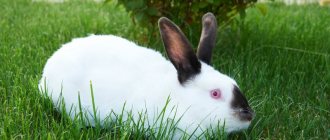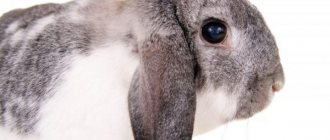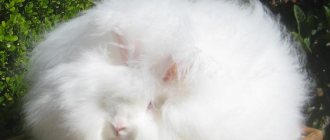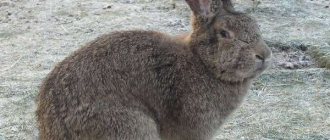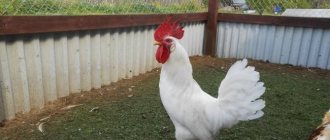History of the breed
White rabbit skins have always been valued higher than regular gray or black ones. After all, such fur can be dyed absolutely any color. At the beginning of the last century, focusing on the needs of light industry, Belgian breeders set themselves the task of developing a new breed of large rabbits with white skin. Flanders were taken as a basis. As a result, a new breed was obtained, distinguished by its large size, absolutely white fur and a very delicate body constitution.
The harsh climatic conditions of Russia were not very suitable for animals of this breed. Therefore, domestic breeders had to improve it. After crossing Belgian individuals with the Soviet chinchilla and the gray giant, domestic rabbits of the white giant breed were bred. You can see photos of these strong, healthy and hardy animals on the page. Domestic giants are unpretentious and tolerate cold and extreme heat relatively well.
Advantages and disadvantages
The white giant rabbit has a number of advantages. The animal gained popularity due to the following parameters:
- Fur. Thick and long (about 4 cm) coat is the hallmark of the breed. Large and soft skin is suitable for sewing a variety of products. Fur can be easily dyed any color.
- Precocity. Already at 3–4 months the animal gains approximately 2.5 kg.
- Saving on feed. The animals do not require specific nutrition, unlike more demanding breeds. Thanks to this, the cost of production is reduced.
- The weight of a rabbit , as a rule, exceeds 5 kg, which is an excellent indicator of meat productivity.
Thanks to the professional and dedicated work of Soviet breeders, the breed is practically free of shortcomings. But still, the white giant has a couple of flaws:
- Due to the significant mass and sparse hair on their paws, animals are prone to the appearance of corns. The problem is partially solved by abandoning mesh floors in favor of solid surfaces.
- Risk of mastitis and fetal dermatitis . Representatives of the breed are susceptible to these diseases, so the owner has to carefully monitor the health of the females.
Breed Features
The characteristic features of rabbits of this breed are:
- white skin and red eyes;
- dense thick hair;
- rounded croup, elongated body and well-developed chest (with dewlap);
- wide straight back;
- straight ears, slightly rounded at the ends.
These are actually very large rabbits. The white giant breed is one of the largest of all those bred to date. The body length of adult individuals can reach 60 cm, chest girth – 37 cm. Based on weight, white giants are divided into three classes:
- first – up to 5.3 kg;
- second – up to 4.8 kg;
- elite – up to 5.8 kg.
One of the undoubted advantages of this breed is its fairly high fertility. Farm owners keeping such rabbits experience virtually no difficulties in breeding them. Female white giants never eat their offspring. On average, a litter usually contains 6-9 rabbits, which is not bad for a large breed. White giants are quite hardy animals that are easy to keep. Young animals grow very quickly and gain slaughter weight by four months. It is not advisable to overexpose rabbits of this breed. Otherwise, the meat will become covered with lard and lose some of its dietary properties.
Keeping and breeding at home
Most giant rabbits do not require special housing conditions. The requirements for their breeding remain the same as for breeding and caring for ordinary rabbits. However, you need to understand that when purchasing giant breed rabbits, you should reconsider cage sizes and feeding.
Cages for giant rabbits
Giant breed rabbits should not be bred in pits. They require increased attention from the owner, which is not feasible in pit conditions.
Giant rabbit cages are different from regular sized rabbit cages. Cages with animals of meat-hide breeds should be placed in the fresh air - this will have a good effect on the quality of the skins. But it is better to keep meat breeds in the basement: in summer such a room will be quite cool, and in winter there will be no drafts. The main thing is that moisture does not accumulate in the basement.
Animals of giant breeds do not tolerate cramped conditions well, so they cannot be kept in standard cages.
Cage requirements:
- cage dimensions for a male rabbit – 80×100×65 cm;
- cage dimensions for a female rabbit with cubs – 100×150×65 cm;
- a solid floor covered with straw or sawdust to prevent animals from injuring their paws or developing corns;
- cleanliness, dryness, absence of unpleasant odor;
- no drafts or overheating.
Giant breed rabbits are not kept in groups. Each individual must have an individual room to avoid fights and death of animals.
Watch an interesting video showing an original cage for giant rabbits.
Feeding
Nowadays, pet supply stores offer a huge selection of food for giant rabbits. There is absolutely no need to buy food for a specific breed. Their composition is approximately the same, so any of these products can be fed to giants. But feed for ordinary rabbits is not suitable here. They do not contain the necessary complex of nutrients, so they will not be a balanced and complete diet for large breed rabbits.
Like ordinary rabbits, giants need to be fed fresh vegetables, grain, and hay. Their diet should include:
- barley and oats;
- hay and silage;
- roots;
- green grass;
- cabbage;
- legumes;
- branches, twigs for sharpening teeth.
Large rabbits should not be fed:
- rotten feed;
- spoiled products;
- food waste from the owner’s table;
- wheat grains or products made from it.
In any case, the owner of giant fluffies should be prepared for the fact that feeding their pets will cost him a considerable amount.
Breeding
Giant breed rabbits can only be mated when the animals reach sexual maturity.
And if in small breed rabbits it occurs at the age of 4-5 months, then in giants it occurs much later - at 7-8 months. Despite such a long waiting period, the owner of giant rabbits will be rewarded: these animals are very fertile. One female brings from 7 to 10 cubs at a time (the exception is the German ram).
Giant breed rabbits are not good at raising their own offspring. They do not have a developed maternal instinct, so they may not build a nest or forget about feeding the young. During the breeding period, the rabbit breeder needs to be especially careful: he must independently open the queen cell (uterine compartment) and, if necessary, make a nest or place the baby rabbits next to the female rabbit for feeding.
At the same time, female rabbits of giant breeds never eat their young, and they have enough milk to feed all their offspring.
If everything went well and the baby rabbits did not die in the first days, then by 1.5 months they will become more independent. Their weight during this period will reach 2 kg. If you add foods rich in protein to your feed, your rabbits will grow very quickly.
The female rabbit stops feeding the cubs after 1.5 months, after which they can be placed in a separate cage. Now the female is ready for mating again.
How to conduct matings
Of course, increasing the number of livestock is one of the main goals of keeping animals such as rabbits on a personal plot. The white giant breed is very simple to breed. However, in order for the herd to be replenished with healthy, well-developing young animals, some rules still need to be followed. The first mating can be carried out no earlier than the animal is six months old. It is also not recommended to bring rabbits together later. Otherwise they may get fat. Mating is carried out in the usual way. That is, the female is placed in a cage with a male, not vice versa.
The White Giant is a breed of rabbits whose crossing usually gives results the first time. However, after two weeks, the mating procedure must be repeated, just in case.
The female carries the young rabbits for about a month. She can bring up to 14 cubs (and feed them all). But giants rarely have offspring in such quantities. Usually a female gives birth to no more than 9-10 rabbits. They are kept with their mother for at least two months. Rabbits placed earlier develop poorly and gain weight.
Reproduction
The white giant rabbit reaches sexual maturity (photos of representatives of the breed can be seen on the page), both female and male, by 6-7 months. Large, active animals with well-furred paws and free of any defects are selected for the tribe. Mating is carried out on the territory of the male. Place the rabbit next to him for 1-2 hours. A control mating is carried out a week later. If the female does not allow the rabbit to approach her, snaps, fights and growls, it means that she will soon have cubs.
Pregnancy in white giant rabbits lasts 30-31 days. The female begins to prepare the nest approximately 1.5 weeks before giving birth. At this time, you need to put a queen cell in the cage. During childbirth, the female must be provided with access to water.
White giant rabbits, the breeding of which usually does not cause any trouble, are distinguished by simply excellent parental qualities. Newborn cubs of females always lie in a pile in the nest, covered with fur. She never scatters them around the cage. To make it easier to observe the development of the litter, the roof of the females’ homes is usually made liftable. It is best to cover the floor with tin. For small rabbits, rats pose a great danger.
Cages and enclosures
The better conditions are created on the farm, the more actively the rabbits will develop. The white giant breed is very large and also quite agile. Therefore, cages for these animals need to be spacious and large. The specific size depends on the class of animals. But in any case, the rabbit should be able to stand up to its full height in the cage and make 2-3 jumps in it.
The white giant is a breed of rabbit, the description of which was given just above, which does not tolerate drafts very well. Therefore, animals must be kept either in cages closed on three sides with thick plywood or in sheds. The lid of the queen cell is usually made hinged. This allows you to easily inspect the nest when the baby rabbits appear. Cages will be needed not only for females with offspring, but also for breeding males (each separately), and for growing young animals.
These rabbits, like most other breeds, are not very resistant to diseases. Therefore, the cells must be kept clean. Disinfection is carried out at least twice a year.
Sometimes white giants are kept in enclosures. The latter must also be large enough - at least a meter high, with an area of at least 80 x 80 cm.
Behavior
White giants are phlegmatic with a peaceful disposition. Their calm nature makes them ideal pets, which is why they can often be seen in apartments. They quickly become attached to their owner and do not show aggression not only towards humans, but also towards other animals. However, if necessary, rabbits can fight back and punish the offender.
Some individuals periodically fall into a trance or stupor, that is, they remain motionless for some time, look at one point and do not react to external stimuli. This behavior is not considered a defect, but is a feature of these albinos.
Features of feeding
Their diet should be varied. The white giant is a large breed of rabbit, and these animals grow quickly. Therefore, their food should contain a lot of proteins. In addition to grass, hay and root vegetables, animals need to be given concentrated feed. White giants also willingly eat leftover bread, cereals and much more. Be sure to put branches of fruit trees, elm, elm, alder, birch, etc. in the cages or enclosure. Crushed barley or oatmeal is most suitable. You need to buy it from trusted suppliers. Various types of rabbit infectious diseases are very often transmitted through food.
Animals must always have clean water in their cages. These animals are fed three times a day. Grass and branches are usually placed in the cage or enclosure in the evenings. It is important to prevent rabbits from eating plants that are poisonous to them. A novice rabbit breeder must know which herbs are contraindicated for these animals. These include, for example, spurge, all types of nightshade, celandine, datura, henbane.
Caring for young animals
Rabbits begin to emerge from the queen cell at approximately 3-4 weeks of age. At the same time, you can start feeding them with fine crushed grains and crackers. There is no need to develop any special diet. The likelihood of intestinal disorders in giant rabbits while they are suckling is very small, and they eat the same thing as a female rabbit.
Babies are taken away from their mother no earlier than 2 months, and preferably at 3. The diet should remain the same. In general, changing the composition of feeds must be done very carefully. The new food is introduced into the diet, adding a dose gradually over about two weeks. These rabbits (the white giant breed), whose breeding is not particularly difficult, gain weight very quickly. However, with insufficient or unbalanced monotonous nutrition, troubles such as developmental delays, yellowing of the skin, etc. are possible. Rabbits are generally animals whose feeding must be approached with the utmost responsibility. The success of their breeding largely depends on this.
Content
As is clear from the name of the breed, rabbits are giants, that is, the animals are large and require spacious cages for comfortable living. The approximate dimensions of the dwelling per individual are 85×110×65 cm. For a female rabbit with offspring, the length and width of the enclosure should be one and a half times larger. In addition, it is advisable to equip the cage for a female with a queen cell - a separate small “house”. The floor in the animals’ home cannot be made of mesh, as this will sooner or later lead to the formation of corns on the paws and the development of pododermatitis. It is better to use slatted or solid coating made of chipboard or plywood.
The cage should be spacious and clean, especially if it contains a female with cubs
The cages must be kept clean. White giants have a fairly strong immune system, but unsanitary conditions can cause various diseases in rabbits, which often leads to a decrease in the rate of weight gain or even death of the animals. Rabbit waste products must be removed from their homes at least once every 2-3 days.
The breed is well adapted to various climatic conditions, so cages can be placed both indoors and outdoors. Thick fur allows rabbits to winter in the cold . The main thing is to avoid drafts and make sure that the animals are not in direct sunlight. Otherwise, they may get heatstroke.
Thick fur protects animals from frost, the main thing is to avoid drafts and overheating
Otherwise, white giants are quite unpretentious and their conditions of detention are not much different from standard ones.
Queen cell
For birthing and feeding the young, the female rabbit is usually built a special cage with a queen cell. This “nest” with approximate dimensions of 35x60x40 cm is attached to the side of the main dwelling.
The ideal material for constructing a queen cell is plywood (5 mm thick). It does not have foreign odors, which is very important, since the female rabbit is very susceptible to them during pregnancy and for some time after giving birth. In order to insulate the structure, the walls and floor are made double - polystyrene foam is usually placed between the layers, and the bottom is covered with straw from the inside. It is better not to use sawdust, because it can get into the respiratory tract of newborn rabbits.
The rabbit's home, equipped with a queen cell
The female bears her offspring for a month, and 1-2 weeks before giving birth, she begins to insulate the floor of the queen cell with her own down.
Feeding
The diet of these rabbits, in fact, coincides with the menu of animals of other breeds. The main thing is that the food contains a sufficient amount of protein necessary for the animal to gain muscle mass. For example, on many specialized farms they are given crushed oat and barley . Feeding wheat is not recommended because it is poorly digested and takes a long time to digest. It is better to supplement grain mixtures with cabbage leaves and vegetable tops. Also suitable for white giants is freshly cut or slightly dried grass (nettle, wormwood, dandelion, wheatgrass, plantain, quinoa).
The choice of plants for rabbits should be approached with the utmost seriousness, as some of the herbs are poisonous. It is strictly forbidden to use spurge, celandine, henbane, and dope.
In winter, in addition to concentrated feed, animals are given hay, as well as brooms from young willow or birch branches (they should be harvested in the summer). Animals of this breed can be fed with grated raw or boiled vegetables, dried bread in very small quantities.
Fresh grass should be present in the daily diet of adults and young animals
A favorite treat for giant rabbits is grated carrots. It is a source of vitamins and helps improve digestion. Pumpkin, zucchini and potatoes can also be included in the animals’ diet, but they eat these vegetables without much enthusiasm. To whet their appetite, the listed products are finely chopped, mixed with fresh herbs and boiled for 60-90 minutes. The resulting gruel is usually fed to white giants as breakfast.
The approximate menu for rabbits of this breed is as follows:
- 60% – concentrated feed;
- 25% – grass, hay;
- 15% – vegetables.
Breeding
Breeding white giants is not difficult. These animals are ready to mate almost all year round. Females are good mothers with a high level of lactation; they give birth to an average of 7-9 rabbits per litter and in most cases successfully feed all offspring.
The impressive size and sufficient amount of milk in the female rabbit allow her to successfully bear and feed her offspring.
It is recommended to allow males who have reached the age of five months to mate, until they have gained excess weight and become passive. A sexually mature female (over 5-6 months old, weighing at least 3.5 kg) is usually mated twice at weekly intervals. If after the first mating she begins to bite, fight back and does not allow her partner to approach her, then fertilization has already occurred.
Caring for baby rabbits
Immediately after giving birth, it makes sense to make sure that all the rabbits are near their mother. If the cub crawls to the side, it risks freezing. Rabbits are born weighing no more than 90 g and quickly gain weight (on average 25 g per day). They have a very sensitive stomach, so new foods should be introduced gradually.
Some babies begin to leave the queen cell at two weeks of age, more often on the 15-20th day of life
At the age of 6-8 weeks, the young are separated from their mother. By this time, the female rabbit is already ready for a new mating and bearing the next offspring.
Rabbit slaughter
The white giant is a precocious breed of rabbit. Young animals, as already mentioned, reach slaughter age at 4-5 months. Animals are killed on homestead farms usually by hitting the back of the head with a stick. First, take the rabbit by the hind legs and wait for him to calm down. This method is considered the most humane. With a sharp blow to the neck, the animal’s vertebrae break and the nervous system is switched off, and therefore it does not feel pain.
Before slaughter, the drinking bowl, hay and feeder are removed from the animal’s cage (12 hours before). The intestines and bladder should be free.
Cutting
The killed rabbit is hung on a crossbar by its hind legs.
The skin is cut around the hock muscles and along the inside of the thighs. Then it is removed like a stocking. The rabbit's head can be cut off immediately after killing. In this case, more blood will drain and the carcass will look better. The cutting is done as follows:
- Using a sharp knife, carefully cut through the abdominal cavity so as not to damage the internal organs.
- The bladder is carefully removed.
- The intestine is cut at the anus. Next, you need to pull it towards you, cutting off the remaining organs. You first need to place a basin under the carcass. A rabbit's stomach and intestines are quite heavy and will simply fall down under their own weight.
- At the next stage, the esophagus and part of the trachea are removed.
- Next, the gallbladder is cut from the liver. This must be done carefully.
Four-month-old animals weigh about 4-4.5 kg. The white giant is a breed of rabbit whose meat yield is about 50% of the carcass weight.
What to do with the skin
White giants are raised not only for meat. The skins of these animals are very large and beautiful. The time of slaughter in this case is determined by the condition of the hair. Young animals are usually killed after the end of the second molt. In this case, the skin is also removed with a stocking. It is very difficult to completely process it at home. Therefore, the removed skins are usually simply preserved. Then they can be handed over to a fur factory or private owners. Preservation is carried out by drying on straighteners. The skin is pulled carefully so that there are no folds left on it.
As you can see, these wonderful rabbits (the white giant breed), breeding and keeping them at home are not too difficult, and are not particularly whimsical animals. The main thing is to feed the animals well and keep the cages or enclosure clean. In this case, the rabbits will quickly gain weight, and their skin will be pure white, without yellowness.
Breeding white giants.
White giants are easy to breed. Hunting among individuals is stable and regular. A female's litter usually consists of 7 to 10 cubs. Trampling and eating rabbits after birth is an extremely rare occurrence. Milk content also does not raise questions (up to 250 grams), although cases of mastitis have been reported. It occurs more often after 2-3 births and especially when kept indoors. This problem can be solved by timely replacement of female rabbits from the replacement herd. Males should be allowed into mating, given the size of the breed, no earlier than 5, and preferably after 6 months. But you shouldn’t over-expose it, as it can become fatty and will only be suitable for soup.
Newborn rabbits quickly gain weight; one might say, they grow like broilers. At 2 months of age, with proper feeding, we have rabbits weighing from 1.5 to 2 kg, at 3 months 2-3 kg, and after another month 2.2-3.5 kg. The weight of an adult rabbit varies greatly, but almost always ranges from 4 to 7.5 kilograms. Babies grow especially well and receive the necessary immunity when fed milk for a long time, so it is recommended to wean them from their mother after 2 months (if possible).
